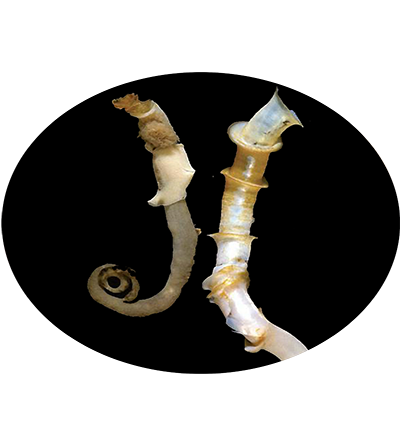
Oasisia alvinae is a tube worm found in a variety of environments on the Juan de Fuca Ridge. Found in clusters up to several square meters in area, these Polychaete’s lack a digestive tract, instead taking up organic carbon from symbiotic, chemoautotrophic bacteria found in their specially-evolved trophosomes. These bacteria oxidize sulfur in order to create organic material. Initially thought to be several species of the Ridgeia genus on the Juan de Fuca Ridge, genetic comparison showed that only one species existed, with various morphologies. The two extreme morphologies are the so-called long-skinny and fat-short forms.
Animalia (Kingdom); Annelida (Phylum); Polychaeta (Class); Sedentaria (Subclass); Canalipalpata (Infraclass); Sabellida (Order); Siboglinidae (Family); Oasisia (Genus); Oasisia alvinae (Species)
Oasisia alvinae Jones, 1985
1. Jones M L. On the Vestimentifera, new phylum: six new species, and other taxa, from hydrothermal vents and elsewhere[J]. Bull Biol Soc Wash, 1985, 6: 117. (Jones et al., 1985)
2. Karaseva N P, Malakhov V V, Galkin S V. The morphology and anatomy of the vestimentiferan worm Oasisia alvinae Jones, 1985 (Annelida: Siboglinidae). III. Coelomic cavity, trophosome and blood, excretory and reproductive systems[J]. Russian Journal of Marine Biology, 2012, 38(2): 122-138. (Karaseva et al., 2012)
East Pacific Rise (N9°48.12′ W103°56.12′)
| Species | Phylum | Common Name | Ecosystem | Depth | Habitat | NCBI Taxonomy ID |
|---|---|---|---|---|---|---|
| Oasisia alvinae | Annelida | - | Deep sea | 2,630 | East Pacific Rise (N9°48.12′ W103°56.12′) | 53619 |
| Genome Assembly | Genome Size | Assembly level | Released year | WGS accession | Submitter | BioProject | BUSCO completeness (%) | Scaffold/Contig N50 (kb) | GC content (%) | Repeat Rate (%) | Gene Number |
|---|---|---|---|---|---|---|---|---|---|---|---|
| - | 808Mb | Scaffold | 2023 | - | QUEEN MARY UNIVERSITY OF LONDON | PRJEB55047 | 96.90 | 2975 | 41.04 | 50.15 | 37,777 |
| Title | Journal | Pubmed ID |
|---|---|---|
| Distinct genomic routes underlie transitions to specialised symbiotic lifestyles in deep-sea annelid worms | nature communications | 37198188 |

